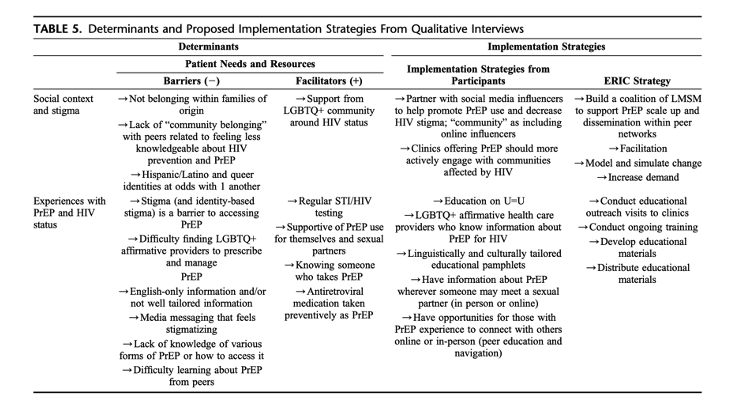| |
Latino PrEP Barriers
"Why Not Just go on PrEP?": A Study to Inform Implementation of an HIV Prevention Intervention Among Hispanic/Latino Men Who Have Sex With Men in the Northeastern United States
|
| |
| |
Download the PDF here
Rogers, Brooke G. PhD, MPHa,b; Toma, Emily MPHa; Harkness, Audrey PhDc; Arnold, Trisha PhDb; Nagel, Katherine BAa; Bajic, Jadea; Maynard, Michaela MPH, MSN, WHNP-BC, NP-Ca; Almonte, Alexi BAa; Nunn, Amy ScDa,d; Chan, Philip MD, MSa,d
Sept 1 2024
excerpts. You must read entire article.
Taken together, these findings suggest that increasing uptake of PrEP among Hispanic/Latino MSM starts by having providers who are affirming, culturally competent, and trained in screening and referral for PrEP.
The scale-up and scale-out of PrEP among MSM at risk for HIV has been largely successful among MSM at risk for HIV within the United States. However, in certain groups experiencing HIV disparities including Hispanic/Latino MSM, the reach of PrEP has not kept up with PrEP need, which has perpetuated existing HIV disparities. Our study focused on identifying specific cultural and/or social factors that could explain the slow rate of adoption among Hispanic/Latino MSM even in the context of access to health insurance, medical care, and a large and thriving academic medical center–based PrEP clinic. Participants reported a need for reduced stigma within clinical visits and more awareness within the broader community to increase PrEP use among Hispanic/Latino MSM. Based on our findings, we suggest specific policy recommendations for consideration, including use of EHR tools to prompt screening and evaluation for PrEP in all settings and payer reimbursement for PrEP screening, counseling, and referral services for all patients. Increased screening at a population health level could help improve equity in PrEP access for Hispanic/Latino MSM and other individuals who may paradoxically be at high need for PrEP yet be least likely to be referred.
Potential policy changes at the clinical level could include screening all adults regardless of perceived sexual orientation or identity for PrEP eligibility as part of a routine wellness visit. Recent CDC guidelines have expanded to include all genders and sexual orientations as appropriate for PrEP and recommend referrals based on behaviors associated with HIV transmission, including limited condom use, multiple sexual partners, and/or drug use.46 To facilitate inclusion of questions related to eligibility for PrEP at wellness visits, clinics could program questions into note templates and/or routine screening prompts within the electronic health record (EHR) so that providers are encouraged to ask questions of all patients. Automation within the EHR could score and evaluate risk, so that if a provider entered certain responses, an alert would activate noting that this was a patient appropriate for PrEP and suggest discussing it with them

|
|
| |
| |
|
|
|